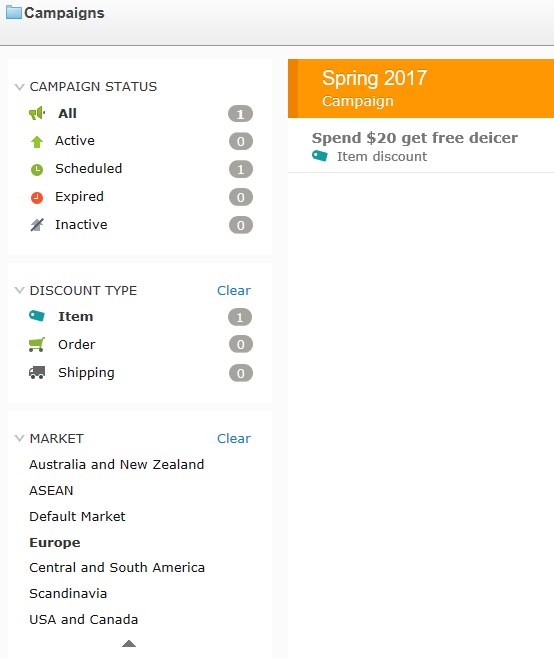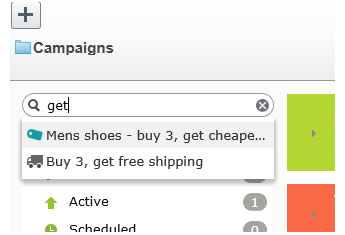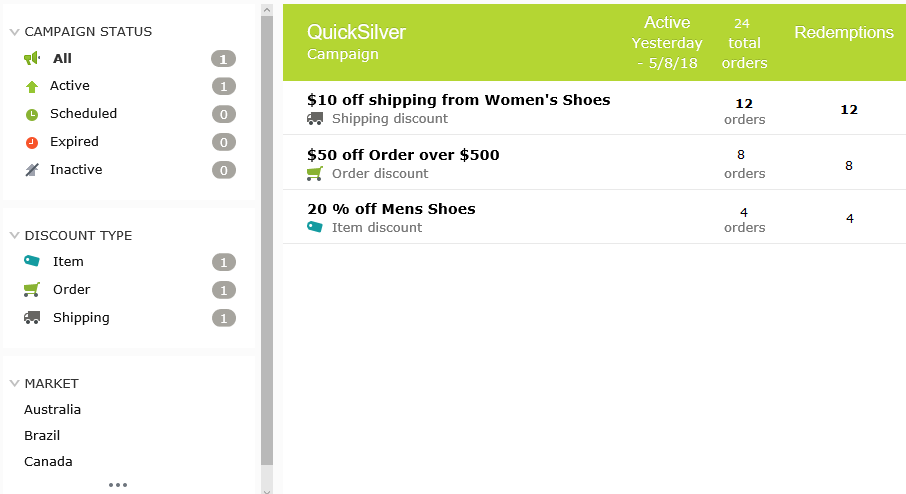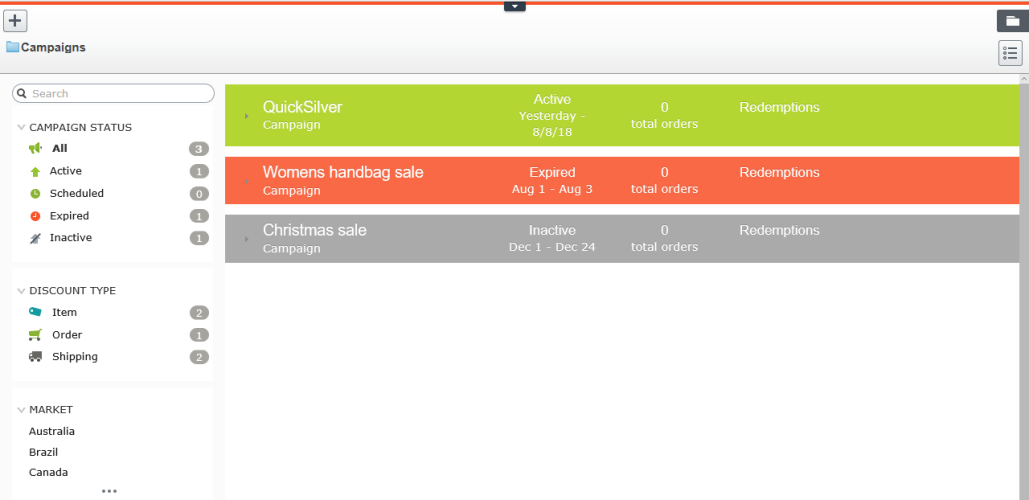 Campaigns and discounts
Campaigns and discounts
The Campaigns feature lets you create campaigns Commerce: a set of related components and activities used for promotions. A campaign organizes marketing activity and is associated with discounts (promotions), customer segments, and markets. to manage discounts Commerce: A deduction applied to an online purchase, typically implemented as part of a marketing campaign. The discount might apply to items, shipping costs, total order amount and so on. when deploying targeted marketing efforts. You can assign a campaign to a specific market, to serve local needs, or to all markets One or more countries, regions or customer groups, to which you want to apply languages, catalogs, currencies or promotions. The market features support targeted merchandising and personalization.. You can also limit a campaign to members of selected visitor groups Site visitors with something in common, such as age, geographic location, and so on. Used in the personalization feature of Optimizely CMS. (See Personalizing Content.).
When setting up a campaign, you define its essential information, such as active date range, target market, eligible visitor groups, and discounts.
Campaign view
To view existing campaigns or create new ones, go to the top menu Group of options that appears in the uppermost part of the user interface when logged in. The global menu displays products and systems integrated with your website. It also displays links to the user guide and user settings, and to a global search. See the User interface topic for further information. and select Marketing. The Campaign view displays each campaign's status and discounts. From Campaign view, you can perform tasks such as create new campaigns, edit existing ones, create and edit discounts, and so on.
Understanding the Campaign View
The Campaign view sorts campaigns by status (identifiable by background color), described below.
- Active (green). Active box is checked, Available from date is in the past, and Expires on date is in the future.
- Scheduled (orange). Active box is checked but Available from date is in the future.
- Expired (red). Active box is checked, but Expires on date is in the past.
- Inactive (gray). Active box is unchecked.
Below each campaign, its discounts appear on a white background.
On the Campaign view, each discount has an icon that illustrates the discount type.
-
 Discount applies to entire order Commerce: A record of a customer's request for goods or services..
Discount applies to entire order Commerce: A record of a customer's request for goods or services.. -
 Discount applies to items.
Discount applies to items. -
 Discount applies to shipping costs.
Discount applies to shipping costs.
The Campaign view also displays numbers for each campaign and discount.
- For each campaign, you see the number of orders that include discounts. If an order has multiple discounts that belong to different campaigns, that order increases each campaign's total.
- For each discount, the Campaign view displays
- the total number of orders that include it.
- redemptions, the number of times a discount reduces cost. For example, a discount provides 20% off all sweatshirts.
- If one order includes three sweatshirts, the redemption for that order is 1.
- If three orders include one sweatshirt each, the discount for all orders is 3.
These numbers are not updated in real time. They are only updated when the Collect orders per promotion statistics scheduled job runs.
Canceled orders do not appear on Campaign View.
Campaign View facets and search
The view's left pane displays facets and a search. Use facets to filter information by selecting a campaign status, and one or more discount types and market One or more countries, regions or customer groups, to which you want to apply languages, catalogs, currencies or promotions. The market features support targeted merchandising and personalization.. If you select facets, the view is refreshed, showing only campaigns and discounts that include your selections. Next to each facet is a number indicating how many campaigns and discounts include it.

Campaign View contains a search to help you find campaigns or discounts. The search only examines campaign and discount titles — it does not consider other fields.

Search tips
- The search ignores any selected facets.
- You need to enter at least two characters to get results.
- The search includes active and inactive campaigns and discounts.
Creating a campaign
To create a campaign, identify the following:
- Schedule
- State (active or inactive)
- Market
- Revenue goals
- Google tracking code
- Visitor groups
- Discounts
- From edit view A section of the user interface where you edit content items, such as pages and blocks. To access edit view, log in and select CMS > Edit. (See admin view for comparison.), select Commerce > Marketing.
- Select Create + > Campaign.
- Assign a name to the campaign. The Edit Campaign view appears.

- Complete its fields using the following information, then click Save.
Field Description Name The campaign name appears. Edit if desired. The name appears on the Campaign view and on dialogs that let users select campaigns. Description Enter a description of the campaign. It only appears on this view. Scheduling and Status Available from Select the date and time when the campaign is available. The campaign is active only if the shopping date/time is between the Available from and Expires on dates/times and the Active box is checked.
The time refers to local time on the Optimizely server. For example, you manage the website from Stockholm, Sweden and set a campaign to expire at 11:00 PM. Due to a nine-hour time difference, for a customer in California, USA, the campaign expires at 2:00 PM.
Expires on Select the date and time when the campaign is no longer available. Active Select the box to make the campaign active, or clear it to make it inactive.
For a campaign to be active, the Active box must be selected and the shopping date/time must be between the Available from and Expires on dates/times.
Active check box examples- When you set up a new campaign (including its discounts), keep Active cleared. When everything is correct, select Active, and the campaign goes live.
- An active campaign is configured incorrectly. Clear Active to pause the campaign, correct it, then select Active to enable it.
Market and Revenue Target markets Select one or more target markets. If you select no markets, the campaign is effectively inactive.
Effects of choosing markets
- If you choose one or more markets, only customers in those markets are eligible to receive this campaign's discounts.
- If you create a discount Commerce: A deduction applied to an online purchase, typically implemented as part of a marketing campaign. The discount might apply to items, shipping costs, total order amount and so on. for this campaign that involves an amount reduction, the list of currencies is determined by the active currencies for countries in the selected markets.
Revenue goal Specify a revenue goal for the campaign.
Optimizely Commerce does not currently use this value—you must manually track campaign revenue.
Tracking Code Use to enter a tracking code for campaign analytics. This field must be specifically implemented for your site.
This tracking code is only a data property. So, for example, you can create a Google Analytics tracking code, use that, then save the code for your campaign to map the data later. Optimizely Commerce does not use the tracking code for any internal functionality.By default, the code is not stored with the order after checkout. But you can get promotions from
IOrderForm.Promotions, then get their campaigns and tracking codes.Personalization If you want to limit this campaign to certain visitor group Site visitors with something in common, such as age, geographic location, and so on. Used in the personalization feature of Optimizely CMS. (See Personalizing Content.), select them. If you do, only group members can use the campaign's discounts. See also: Commerce-specific visitor group criteria.
If more than two visitor groups are selected, hover over the ellipsis to see them all.
Discounts See Discounts
Editing a campaign
- From the Campaign view, hover over a campaign. On the far right side, a context menu appears.
- Select Edit.
- Modify the fields.
Deleting a campaign
- From the Campaign view, hover over a campaign. On the far right side, a context menu appears.
- Select Delete.
Deleting a campaign cannot be undone, and all discounts created for the campaign are also deleted.
See also:Discounts
